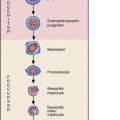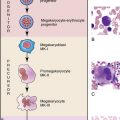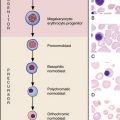2 HEMATOPOIESIS
Hematopoiesis is a vigorous process of blood cell production and maturation that in the adult occurs primarily in the bone marrow. The process begins with the pluripotential hematopoietic stem cell (multipotent progenitor), which is capable of proliferation, replication, and differentiation. In response to cytokines (growth factors), the pluripotential stem cell will differentiate into a common myeloid or common lymphoid progenitor. Both the myeloid and lymphoid progenitors maintain their pluripotential capacity. The lymphoid progenitor proliferates and differentiates into T, B, and natural killer cells. The myeloid progenitor proliferates and differentiates into granulocyte, monocyte, erythrocyte, and megakaryocyte lineages. To this point in maturation, none of these stem cells can be morphologically identified, although it is postulated that they appear similar to a small resting lymphocyte. The blue shaded area in Figure 2-1 highlights the stem cell populations. Each lineage and maturation stage will be presented in detail in the following chapters.
Stay updated, free articles. Join our Telegram channel

Full access? Get Clinical Tree









